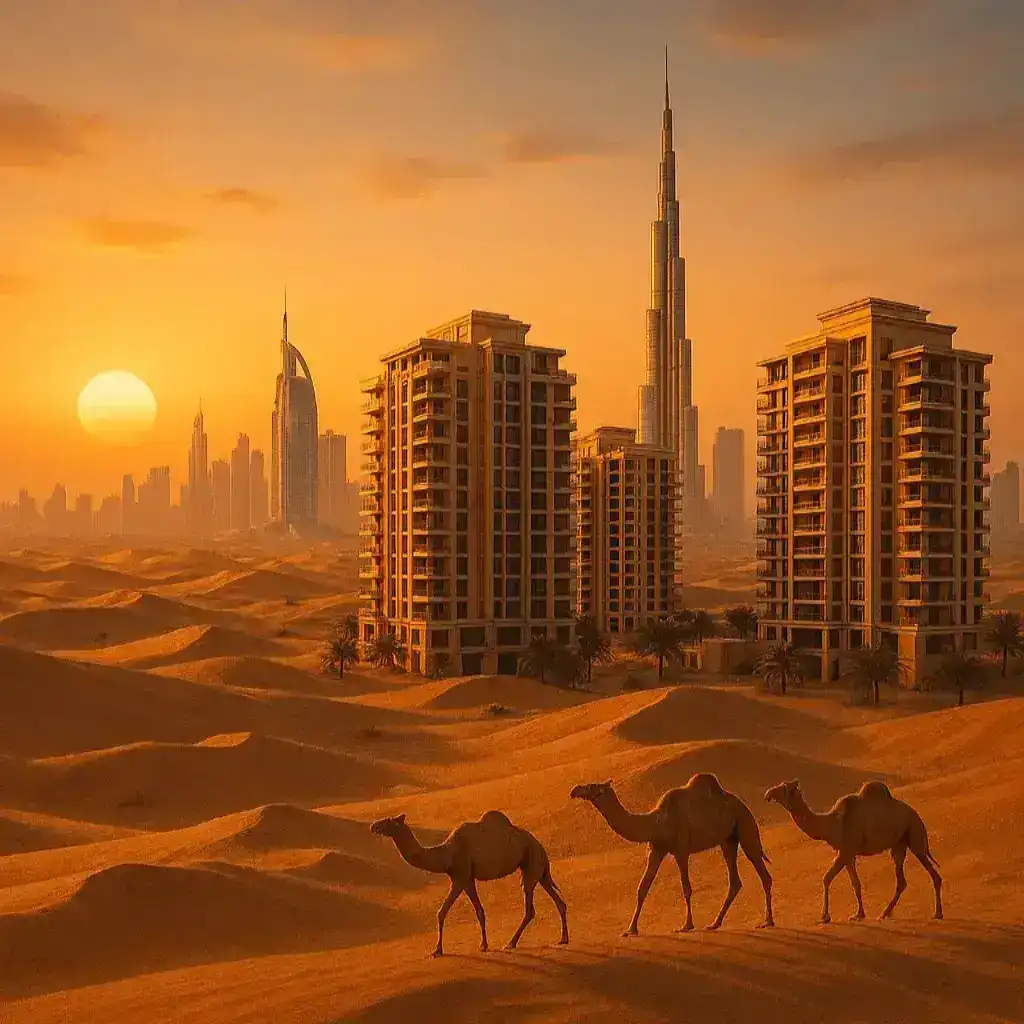Oasis of Opportunity: Desert Tourism's Golden Touch on Property Values
Have you noticed how homes near Dubai's desert playgrounds are fetching jaw-dropping prices these days? It's no mirage. Properties rubbing shoulders with popular desert attractions have been quietly outshining Dubai's already glittering market performance, with value jumps of 15-22% above city averages since 2020 . Take a stroll through Arabian Ranches or Dubai Hills Estate and you'll spot estate agents practically giddy when mentioning the "desert premium" – that magical selling point that lets them add a few extra digits to the price tag with surprising ease.
The Desert Premium Effect
The emerging "desert premium" has transformed once-overlooked locations into some of Dubai's most coveted addresses, creating new hotspots for investors seeking strong appreciation potential and resilient property values.
| Location | Average Price Increase Since 2020 | Desert Premium Factor | Primary Buyer Demographics | Investment Outlook |
|---|---|---|---|---|
| Arabian Ranches | 27% | 18% | European Tech Entrepreneurs, Gulf Investors | Very Strong |
| Dubai Hills Estate | 24% | 15% | Multinational Executives, Asian Investors | Strong |
| Al Barari | 31% | 22% | Ultra-High Net Worth Individuals | Exceptional |
| Damac Hills | 19% | 14% | Professional Expatriates, Mid-level Investors | Strong |
| Downtown Dubai (Comparison) | 12% | N/A | Traditional Luxury Buyers | Moderate |
Money talks, and lately it's been speaking fluent "desert-ese." Last year, roughly 7.8 billion dirhams found their way specifically into properties with desert connections – that's a cool $2.1 billion voting with its wallet. The interesting cocktail of investors has shifted too; where once Russian oligarchs and Gulf royalty dominated, now you'll spot German tech entrepreneurs, Shanghai business magnates, and Bangalore software moguls touring these properties.
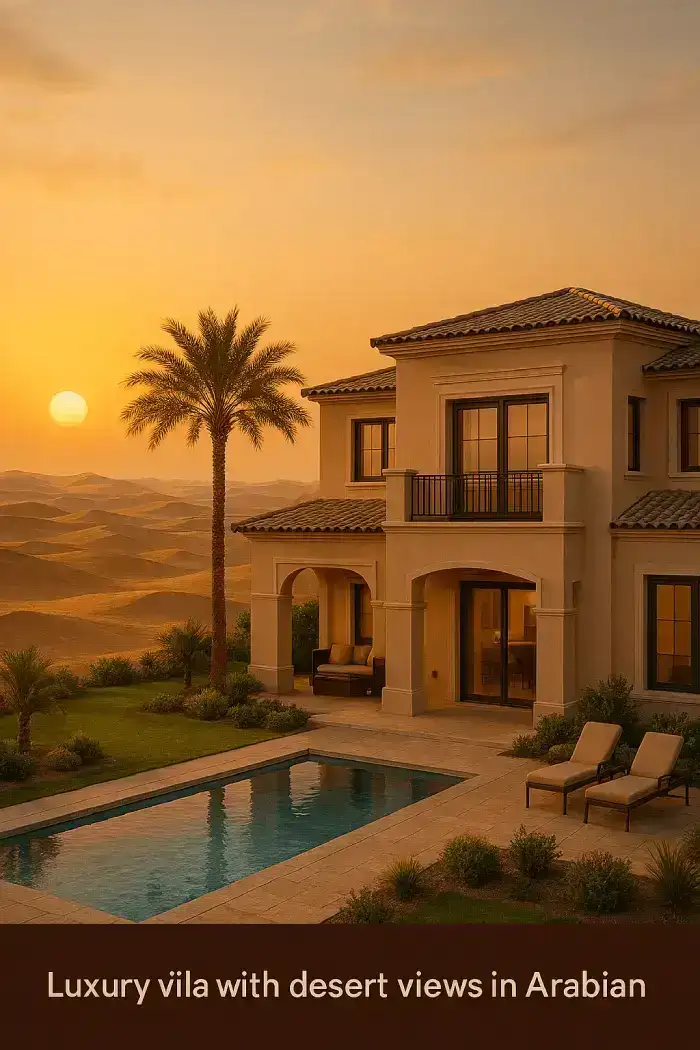
A premium property in Arabian Ranches showcasing the "desert premium" with panoramic views of Dubai's natural landscape.
I've been selling Dubai property for 15 years, and I've never seen anything like the current desert-adjacent market. Buyers who once insisted on sea views are now competing fiercely for unobstructed desert vistas. Last month, I sold a villa for 3.2 million dirhams above asking price solely because it had the best dune views in the development.
"Weather any storm in the desert" might sound like a Bedouin proverb, but it's actually the new mantra among savvy property managers. While downtown high-rises occasionally battle vacancy demons during market hiccups, these sand-kissed properties somehow maintain occupancy rates north of 85% year-round.
Experiential Rental Strategy
Properties offering "Sunrise Dune Breakfasts" or "Private Stargazing Experiences" routinely command 12-18% higher rents than their identical, experience-lacking twins across the street. This experiential approach to property management has created a new paradigm in Dubai's rental market.
Moving to our Arabian Ranches villa was the best decision we've made. The premium we paid for desert views has been more than compensated by the lifestyle benefits. Our children have developed a deep appreciation for the natural environment, and the organized desert experiences have become the highlight of our weekends. The property value has increased 19% in just 18 months - far outpacing our previous investment in Dubai Marina.
— Hans Mueller, German Tech Executive and Arabian Ranches Resident
The commercial real estate folks weren't about to miss this gold rush either. What began as a few brave coffee shops and gear-rental outposts has blossomed into thriving micro-economies where desert adventure companies, boutique experience curators, and high-end retailers cluster along the urban-desert boundary.
-
Commercial Property Performance:
- Desert-adjacent commercial spaces boast 92% occupancy rates compared to the 78% downtown average
- Retail spaces specializing in outdoor and adventure equipment report 24% higher per-square-foot revenue
- Food and beverage outlets with desert views command 35% higher rental rates
- Commercial investors are increasingly targeting properties within 1-3 km of major desert attractions
For three decades I chased prime spots in Dubai Marina. Now I chase views of nothing but sand, and my tenants couldn't be happier paying premium for that nothing. The commercial properties in our desert-adjacent development have maintained near-full occupancy through two market cycles that saw significant vacancies downtown.
Sand Castles and Sky Scrapers: Architectural Innovation Driven by Desert Experience
Dubai's architectural soul-searching has taken a fascinating turn lately. The city that once seemed determined to forget its desert roots through ever-taller glass towers now finds its most celebrated architects drawing inspiration from the very sands they once conquered.

Step inside developments like The Sustainable City or the stunning Desert Leaf Residences and you'll notice how windows now frame desert panoramas like priceless artwork, color schemes dance with the dunes' shifting palettes, and living spaces spill seamlessly outward beneath starlit skies. One resident described her new home as "not so much built on the desert but having conversations with it daily."
The scramble for desert views has sparked a quiet revolution in how buildings reach for the sky. Floor plans now rotate, twist, and cascade to maximize the number of units with unobstructed desert vistas, with those lucky enough to face the endless sands commanding premiums up to 30% above their city-facing neighbors.
We used to build around golf courses. Now we approach desert views with even greater reverence. I've redesigned entire tower positions because our studies showed we could gain eight more premium desert-view units by shifting just 12 degrees eastward. The return on investment for these adjustments has been extraordinary.
Technological Innovation in Desert-Appropriate Building
Behind the aesthetic revolution lies a technical one just as profound. A specialized glass industry has bloomed in Dubai, developing panes that perform magic tricks – inviting desert views in while keeping its punishing heat out. These technological marvels reduce energy consumption by up to 35% compared to conventional materials.
| Desert-Adapted Technology | Energy Savings | Cost Premium | ROI Timeline | Market Value Impact |
|---|---|---|---|---|
| Advanced Desert Glass | 35% | +15% | 3.5 years | +8-12% property value |
| Modern Wind Towers (Barjeels) | 28% | +9% | 4 years | +5-9% property value |
| Desert-Optimized Insulation | 32% | +12% | 3 years | +6-10% property value |
| Smart Shade Systems | 25% | +18% | 5 years | +10-15% property value |
| Desert Microclimate Control | 40% | +22% | 4.5 years | +12-18% property value |
"We created a glass that's basically having an argument with the sun all day and winning," jokes Omar Al-Farsi, founder of DubaiGlaze Innovations, one of at least 12 local companies now focused exclusively on desert-appropriate building technologies. "Twenty years ago, we imported everything from Germany and Japan. Today, they're studying our solutions."
As an architect who's worked in both Europe and the Middle East, I'm astounded by how quickly Dubai has developed desert-specific building technologies. The seamless transition between indoor comfort and desert vistas in my Desert Leaf residence is remarkable. Even in August, my energy bills are 40% lower than in my previous apartment, despite having twice the square footage. The building truly respects and celebrates its desert context rather than fighting against it.
— Marcus Chen, International Architect and Desert Leaf Resident
Venture to the edges of these properties and you'll discover perhaps the most subtle yet significant innovation – the disappearing boundary. Where harsh fences or walls once announced "development ends here," landscape architects now orchestrate gradual transitions using indigenous plants and natural contours that make it nearly impossible to tell where manicured grounds end and wild desert begins.
-
Landscape Integration Features:
- Transition zones stretching hundreds of meters using indigenous plants
- Natural contours and materials that blend with the surrounding desert
- Properties with thoughtful transitions fetch 15-20% premiums
- Reduced maintenance costs compared to traditional landscaping
- Enhanced wildlife viewing opportunities becoming key selling points
We finally stopped fighting the desert and started dancing with it instead. The boundaries between our developments and the natural landscape are intentionally blurred, creating experiences that change with the seasons, the light, and even the direction of the wind. Buyers are willing to pay significant premiums for this harmonious approach.
Luxury Redefined: Desert Experiences Elevating Premium Property Markets
The meaning of "luxury living" in Dubai has undergone a subtle yet seismic shift. Where imported marble and gold fixtures once reigned supreme, today's ultra-wealthy homebuyers increasingly ask first about the quality of desert experiences accessible from their potential purchase.
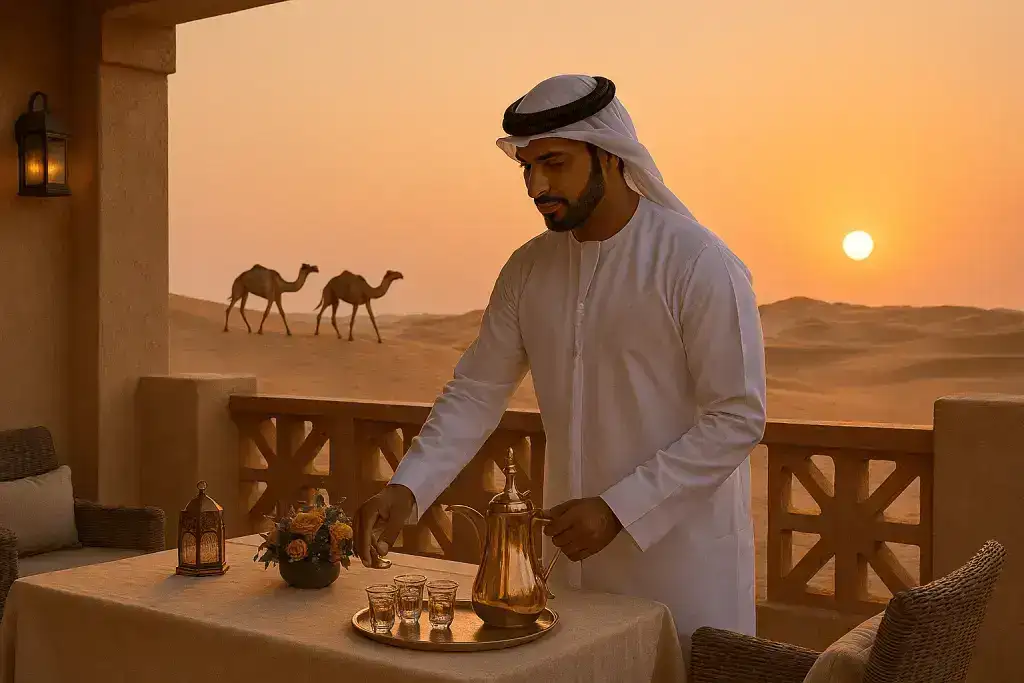
A private desert concierge arranging an exclusive sunrise falconry experience for residents of Dune Estates.
The Rise of Experience-Based Amenities
Developments like the breathtaking Desert Mirage and exclusive Dune Estates have taken note, embedding private "desert concierges" into their staff – specialists who arrange everything from sunrise falconry displays to midnight astronomical tours tailored exclusively for residents. These bespoke services, typically valued between 50,000-75,000 dirhams annually , have become the new must-have amenity.
"Pathway to nowhere" might sound like a real estate disaster, but in Dubai's premium market, these carefully negotiated private access corridors to protected desert conservation areas have become the ultimate status symbol. Imagine having your morning coffee, then strolling directly from your garden into pristine, protected dunes that the general public can't access – that privilege now commands staggering premiums of 35-45% above comparable homes without such access.
| Luxury Desert Amenity | Annual Service Value | Property Premium Effect | Target Demographic | Market Trend |
|---|---|---|---|---|
| Private Desert Concierge | 50,000-75,000 AED | +18-25% | Ultra-High Net Worth Individuals | Rapidly Growing |
| Private Conservation Access | N/A (Asset Value) | +35-45% | Environmental Enthusiasts, Privacy Seekers | Highest Demand |
| Branded Desert Experiences | 30,000-65,000 AED | +15-22% | Status-Conscious Luxury Buyers | Strong Growth |
| Private Helipad Access | Varies by Usage | +20-30% | Ultra-Mobile Executives, VIPs | Selective Demand |
| Desert Vehicle Garage | 15,000-25,000 AED | +8-15% | Adventure Enthusiasts, Collectors | Steady Growth |
I sold two identical villas last month. The one with conservation area access went for 12 million dirhams more. The buyer never even blinked at the difference. When I asked why this feature was so important, he simply said, "I can build another swimming pool anywhere. I cannot build another piece of pristine desert."
The marriage between five-star desert hospitality and residential living has produced some fascinating offspring. International luxury brands that once limited their presence to hotels now partner with developers to create residential experiences infused with desert heritage.
Returning home after international travel to find my living room transformed into a private majlis with musicians, authentic cuisine, and storytellers – all arranged by my residence staff – is an experience beyond traditional luxury. Last month, our desert concierge arranged a private astronomical experience where a renowned physicist explained the night sky to our family from our own private observation deck. These experiences simply cannot be purchased in traditional luxury developments at any price.
— Hiroshi Tanaka, CEO and Resident of Branded Desert Residence
Perhaps most telling about the evolving definition of desert luxury is the emergence of transportation amenities once considered merely utilitarian as status symbols in their own right. Helicopter landing pads, climate-controlled garages for specialized desert vehicles, and even small private airstrips have become coveted features in ultra-premium developments.
-
Evolution of Luxury Desert Transportation:
- Private helicopter landing facilities for direct desert access
- Specialized vehicle garages with climate control and maintenance services
- Small private airstrips for ultimate accessibility
- Concierge transportation services with specialized desert vehicles
- Properties with premium transportation amenities command 25-35% higher prices
Five years ago, clients asked about smart home technology. Today they ask whether their Figeac can land directly on the property for desert excursions, or if they'll need to drive to a commercial helipad. The desert isn't just a view anymore – it's a destination these buyers want immediate, private access to whenever the mood strikes.
Digital Nomad Oasis: Remote Work Reshaping Desert-Adjacent Communities
Who would have predicted that Dubai's desert fringes would become the promised land for laptop warriors? Yet here we are in 2025, with developments like Nomad Valley and Desert Work Hub transformed into thriving communities of location-independent professionals.
Remote Work Revolution in the Desert
These modern-day oases offer a compelling cocktail of high-speed connections (blistering 2.5 Gbps in recent tests), thoughtfully designed work spaces, and the soul-soothing backdrop of endless dunes just beyond the window. With year-round occupancy rates hovering around 92% , these digital nomad-focused communities aren't just surviving – they're thriving in a rental market segment they essentially invented from scratch.
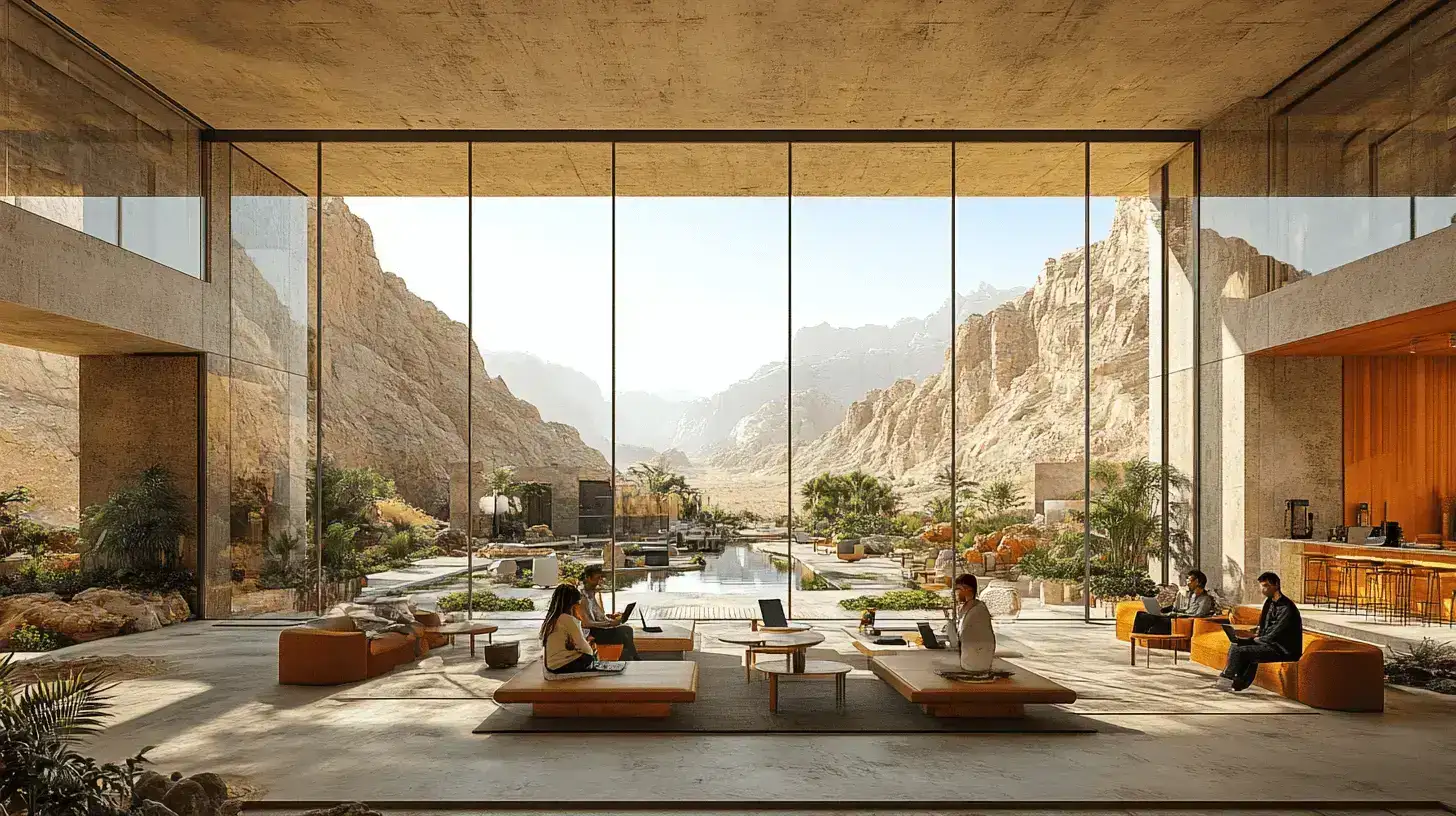
"I designed standard apartments for 15 years before switching to nomad-focused properties," reveals Aisha Mahmoud, lead architect at Future Living Designs. "Everything changes when you assume work happens throughout the home, not just in some tucked-away office nook." This philosophy manifests in fascinating ways: sound-isolated work pods with panoramic desert views, covered outdoor working terraces designed to remain comfortable even in summer heat, and electrical systems robust enough to support professional equipment.
The market has responded enthusiastically to these purpose-built spaces, rewarding developers with rental premiums between 22-28% compared to conventional properties of similar size and location.
| Digital Nomad Community | Connectivity | Occupancy Rate | Rental Premium | Tenant Renewal Rate |
|---|---|---|---|---|
| Nomad Valley | 2.5 Gbps Fiber | 94% | 28% | 79% |
| Desert Work Hub | 2.2 Gbps Fiber | 92% | 25% | 76% |
| Digital Dunes Residences | 2.4 Gbps Fiber | 91% | 24% | 73% |
| Oasis Workspaces | 2.0 Gbps Fiber | 89% | 22% | 68% |
| Standard Dubai Apartments (Comparison) | 1.2 Gbps Typical | 78% | N/A | 58% |
Community managers in these developments have essentially become part-time events directors, recognizing that their nomadic residents crave both connection and solitude in unpredictable measures. Scheduled networking events, skill-sharing workshops, and guided desert experiences create the social fabric that many remote workers desperately miss.
Monday morning meditation on the dunes, Wednesday evening coding challenges under the stars, weekend desert photography treks – our calendar stays full. Our community programming isn't just about entertainment; it's about creating the social infrastructure that remote workers need to thrive professionally and personally in a nomadic lifestyle.
After working remotely from 14 countries, I've finally found my ideal base at Desert Work Hub. The combination of world-class connectivity, purpose-built workspaces, and the psychological benefits of the desert landscape has transformed my productivity. In Zurich, I stared at other buildings while coding. Here, I watch falcons hunt while debugging. My productivity has never been higher, and I've extended my initially planned 3-month stay indefinitely.
— Thomas Meier, Swiss Software Engineer at Desert Work Hub
Peek into the passport stamps and LinkedIn profiles of these communities' residents and you'll spot fascinating patterns that diverge sharply from Dubai's traditional expatriate demographics. Europeans, North Americans, and East Asians make up nearly three-quarters of residents, with significantly higher percentages of Scandinavians, Canadians, and Japanese than found elsewhere in Dubai.
-
Digital Nomad Community Demographics:
- 65% of residents fall between 28-42 years old
- Growing segment of "digital senior nomads" in their 50s and 60s
- Europeans, North Americans, and East Asians comprise 75% of residents
- Higher concentration of Scandinavians, Canadians, and Japanese than elsewhere in Dubai
- Most cite the desert's psychological benefits as their primary reason for choosing these locations
Environmental Stewardship: Sustainable Desert Development Setting New Standards
Gone are the days when "sustainable desert development" sounded like an oxymoron in Dubai. Today's buyers increasingly demand proof that their desert-adjacent dream homes tread lightly on the fragile ecosystems they showcase.
The Green Desert Premium
Properties incorporating comprehensive water recycling systems, solar infrastructure tailored to desert conditions, and landscaping that celebrates rather than fights local ecology now command premiums of 12-18% over conventional developments . This market-driven validation has unleashed a wave of innovation, with nearly 1.4 billion dirhams poured into research and implementation of desert-specific building practices since January 2024 alone.
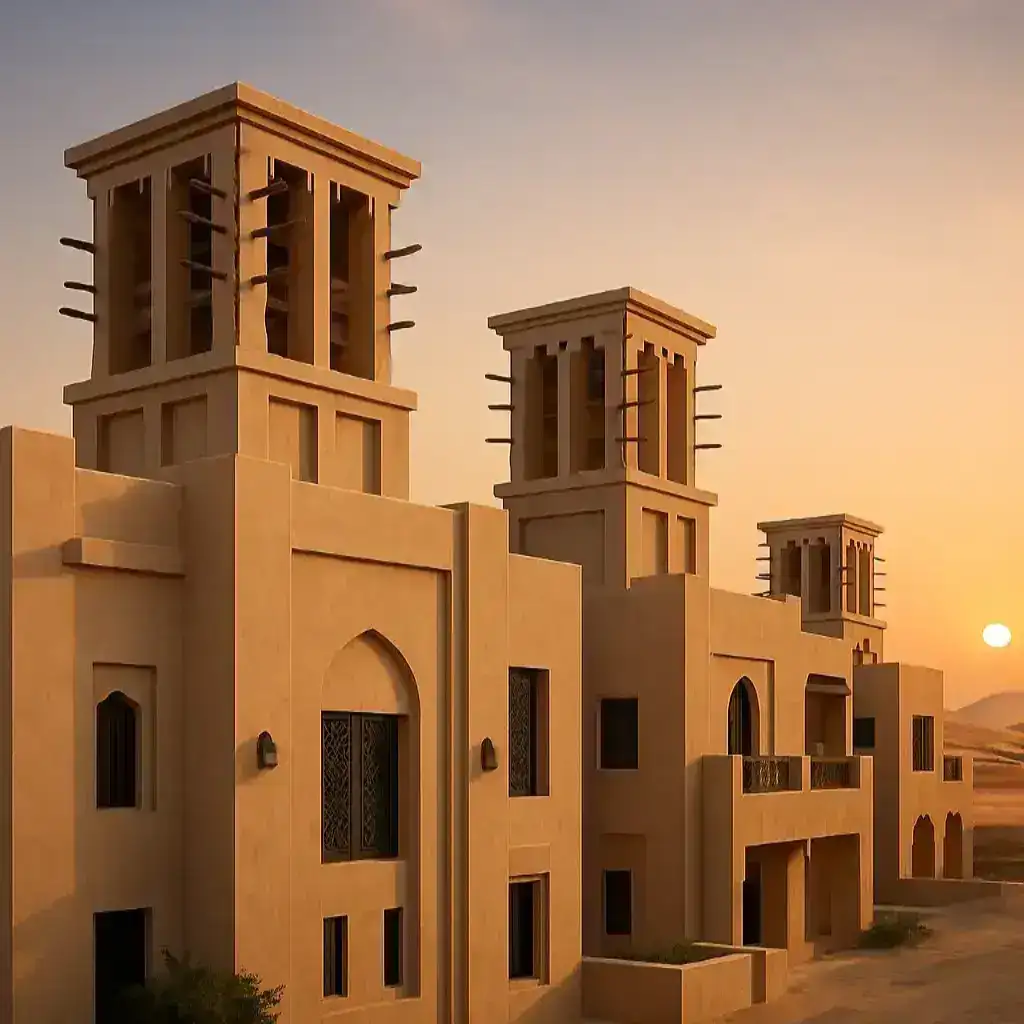
Modern interpretation of traditional wind towers (barjeels) at a sustainable luxury development that maintains comfortable temperatures while slashing energy consumption.
What happens when ancient Bedouin building wisdom meets cutting-edge technology? Magic, apparently. The revival of traditional desert architectural elements – reimagined through modern engineering – has produced buildings that whisper rather than shout their innovation.
| Sustainable Desert Feature | Resource Savings | Initial Cost Premium | ROI Timeline | Buyer Premium Willingness |
|---|---|---|---|---|
| Modern Wind Towers (Barjeels) | 40-55% Energy | +12% | 4-6 years | +15% |
| Atmospheric Water Harvesting | 20-35% Water | +18% | 5-7 years | +14% |
| Advanced Gray Water Recycling | 55-65% Water | +10% | 3-5 years | +12% |
| Desert-Adapted Landscaping | 70-80% Water | +8% | 2-3 years | +10% |
| Wildlife Corridor Integration | N/A (Ecological) | +15% | N/A (Value-Add) | +18% |
My grandfather used these same principles to stay cool without electricity. We've simply added some 21st-century sophistication to wisdom that survived a thousand summers. The market response has been extraordinary - buyers are willing to pay significant premiums for homes that honor traditional desert wisdom while incorporating modern technology.
The unlikely romance between profit-driven developers and passionate conservationists has blossomed into one of Dubai's most productive partnerships. Joint ventures between real estate firms and environmental organizations have established new development models that incorporate wildlife corridors, indigenous plant sanctuaries, and educational components showcasing desert ecology.
Environmental Value Proposition
Far from being cost centers, these conservation initiatives have proven to be powerful marketing differentiators. Recent market research reveals that 68% of luxury property buyers now rank environmental responsibility as "important" or "very important" in their purchase decisions – up dramatically from 46% just five years ago.
As a lifelong environmental advocate, I never imagined I'd purchase property in Dubai. The wildlife corridor and indigenous plant sanctuary integrated into our development completely changed my perspective. Our children regularly participate in the ecological education programs, and we've spotted rare desert species from our terrace. The developers have created something truly special - a luxury community that enhances rather than damages the desert ecosystem. We paid a premium for this approach and consider it money well spent.
— Dr. Emma Richardson, Environmental Scientist and Homeowner
Water – the desert's most precious resource – has inspired perhaps the most impressive innovations. Developments now showcase atmospheric water harvesting systems that literally pull drinking water from desert air, advanced gray water recycling that turns shower water into landscape irrigation, and smart systems that reduce consumption by up to 65% compared to properties built just a decade ago.
-
Water Conservation Innovations:
- Atmospheric water generation systems producing up to 300 liters daily
- Gray water recycling systems reclaiming 90% of household water
- Smart monitoring systems reducing overall consumption by 65%
- Desert-adapted landscaping requiring minimal irrigation
- Water-conscious features maintain price premiums of 8-14% even during market corrections
Five years ago, buyers barely glanced at water efficiency data. Today they interrogate me about water recovery percentages and drought-resistant plant species with the intensity previously reserved for countertop materials and bathroom fixtures. The market has fundamentally changed – and for the better.
Cultural Convergence: Heritage Tourism Influencing Property Development
The hunger for authentic cultural connections has sparked something extraordinary in Dubai's property sector – a renaissance of traditional design reimagined for contemporary living. Developments like Heritage Sands and Al Seef Residences have become showcases where traditional Emirati architectural elements, materials, and spatial concepts find new expression in modern homes.
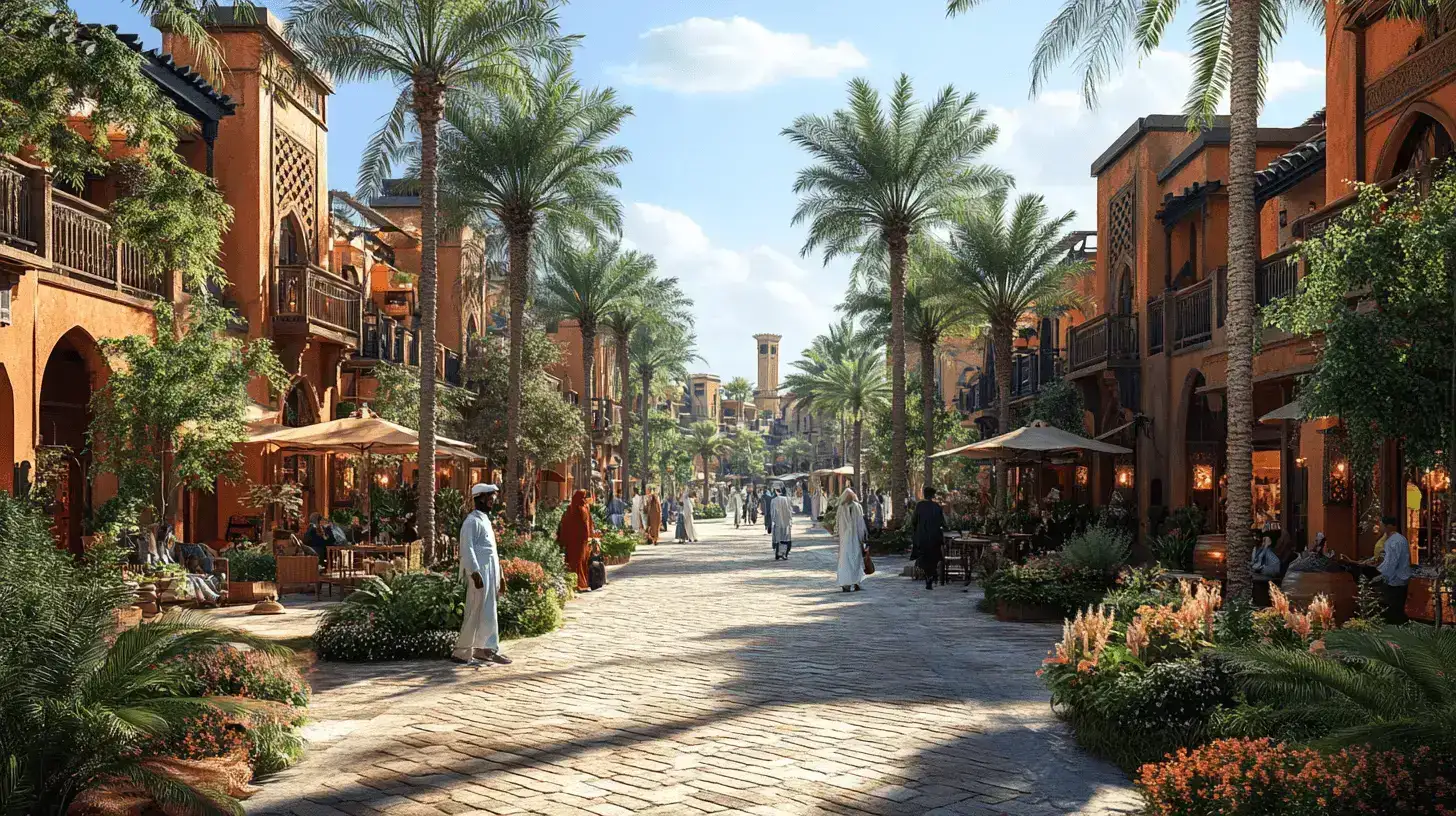
These properties – neither museum pieces nor generic international-style buildings – offer residents daily immersion in cultural heritage while sacrificing none of the comforts expected in premium developments. Market response has been enthusiastic, with these culturally authentic properties selling 1.3-1.6 times faster than comparable alternatives lacking heritage elements.
I could have purchased a similar villa for less elsewhere, but nowhere else could I give my children this daily connection to Emirati culture. That's worth every extra dirham. Living in a space that honors architectural traditions while providing modern comfort has deepened our appreciation for the rich heritage of our host country.
Cultural institutions have emerged as powerful anchors that magnetize property values in their vicinity. The data tells a compelling story: homes within easy walking distance (500 meters) of significant heritage centers, museums, or performance venues dedicated to local culture show price appreciation 7-12% higher than comparable properties lacking such proximity.
Cultural Anchors and Property Values
This valuation boost has fundamentally altered developer calculations, transforming cultural components from nice-to-have amenities into essential value drivers. Some forward-thinking master plans now begin by identifying existing heritage sites to preserve or determining optimal locations for new cultural venues before a single residential unit is designed.
| Cultural Anchor Type | Property Value Impact (500m Radius) | Annual Visitor Traffic | Commercial Space Premium | Development Trend |
|---|---|---|---|---|
| Heritage Centers | +10-12% | 250,000-400,000 | +18% | Strong Growth |
| Cultural Museums | +8-11% | 300,000-500,000 | +15% | Steady Growth |
| Traditional Craft Workshops | +7-9% | 150,000-250,000 | +12% | Emerging Focus |
| Performance Venues | +9-12% | 200,000-350,000 | +16% | Strong Growth |
| Indigenous Botanical Gardens | +7-10% | 180,000-300,000 | +11% | Rapid Growth |
Educational tourism focused on desert heritage has breathed new economic life into previously overlooked areas, creating property hotspots where none were anticipated. Neighborhoods adjacent to traditional craft workshops, historical pearl diving exhibits, and indigenous botanical gardens have experienced surprising value surges as tourists and residents alike seek meaningful learning experiences.
We purchased our property adjacent to the Desert Heritage Center primarily as an investment, attracted by the favorable pricing compared to more established areas. Three years later, our property has appreciated by 32%, and the vibrant cultural scene that has developed around the center has completely transformed the neighborhood. The educational tourism brings a steady stream of respectful visitors who support local businesses without creating the overcrowding issues seen in purely commercial tourist areas.
— Ahmad Al-Jabri, Property Investor and Resident
Specialized real estate investors have taken notice, with several funds collectively directing nearly 920 million dirhams toward properties strategically positioned near educational tourism assets during the past eighteen months.
We initially focused exclusively on luxury beachfront. Now 30% of our portfolio targets properties with strong educational tourism connections – they've consistently outperformed our traditional investments since 2023. The cultural tourism sector has proven remarkably resilient even during broader market fluctuations.
The rhythm of cultural celebrations has become an invisible but powerful force shaping property valuations, particularly in the rental investment sector. Units located near major festival grounds or heritage celebration venues achieve premium rental rates during cultural events that can exceed standard rates by 30-45%.
-
Cultural Calendar Impact on Property:
- Premium rental rates during festivals exceed standard rates by 30-45%
- Properties designed with festival viewing areas command year-round premiums of 15-20%
- Flexible community spaces that transform for cultural events increase property values
- Developments that actively participate in cultural celebrations report higher resident satisfaction
- Cultural programming creates community bonds that result in higher tenant retention rates
This temporal dimension of property value has inspired developers to create flexible spaces specifically designed to harmonize with the cultural calendar – communal areas that transform from everyday use to festival viewing platforms, rooftop terraces positioned for optimal views of traditional celebrations, and adaptable venues that host cultural workshops throughout the year.
Cultural Integration as Development Philosophy
The most successful developments have essentially become year-round cultural participants rather than mere spectators, weaving themselves into the fabric of Dubai's living heritage. This approach creates developments that don't simply occupy space in Dubai but actively contribute to its cultural landscape.
For the first time, we're seeing development that doesn't replace culture but amplifies it – creating spaces where traditions aren't merely preserved but actively flourish. This represents a profound shift in how we conceptualize the relationship between real estate development and cultural heritage.
As Dubai continues its remarkable evolution, the integration of desert tourism with innovative real estate development represents one of its most successful and sustainable growth stories. The synergy between cultural heritage, environmental stewardship, architectural innovation, and lifestyle experiences has created property value propositions that resonate deeply with both investors and residents, setting new standards for development across the region and beyond.

